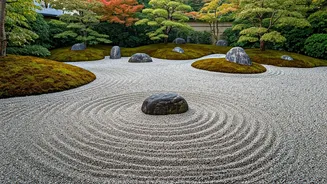The Never-Ending Chase
The relentless pursuit of the latest trend has become a hallmark of contemporary society. This phenomenon is driven by a complex interplay of factors,
including the media, marketing strategies, and the human desire for social acceptance. The continuous emergence of new products, styles, and ideas creates a sense of urgency, compelling individuals to constantly update their preferences and possessions to remain relevant. This constant chasing can be traced to fundamental human needs, like the drive to belong and the fear of missing out (FOMO). This constant state of 'new' means that people are often stuck on a never-ending merry-go-round, chasing the next exciting thing. Consequently, people may experience a feeling that they're never truly 'caught up' or satisfied because the goalposts keep shifting. This can lead to a sense of anxiety and dissatisfaction, creating a continuous loop of consumption and aspiration.
Psychological Impact Explored
The pressure to stay abreast of trends has profound psychological effects. The perpetual exposure to novelties can trigger feelings of inadequacy and anxiety. When individuals compare themselves to others who seem to be effortlessly embracing the latest trends, they may experience self-doubt and lower self-esteem. This constant self-comparison fuels the cycle, as people try harder to keep up and gain approval. Moreover, the fear of missing out intensifies these feelings. The perception that others are enjoying experiences or possessing items that one lacks creates a sense of social pressure and unease. This can lead to impulsive purchases, overspending, and a general feeling of being overwhelmed. The mental health repercussions can range from mild stress to more serious conditions like anxiety and depression. Understanding these impacts is the first step toward breaking free.
Breaking Free Strategies
Finding calm and breaking free from the trend cycle requires a conscious effort to challenge societal expectations. The first step involves recognizing the cycle and its negative effects. Cultivating self-awareness allows individuals to identify their triggers and patterns of behavior. This can lead to an increased understanding of when and why they are pulled into the trend cycle. Implementing strategies to limit exposure to these triggers, such as reducing time spent on social media or in environments where trends are heavily promoted, is also essential. Moreover, fostering a sense of contentment with what one has and focusing on intrinsic values, such as relationships and personal growth, helps build resilience. This involves valuing experiences and inner qualities rather than external markers of trends. Setting boundaries, practicing mindfulness, and embracing a more deliberate and considered approach to consumption helps in creating lasting peace.
Cultivating Inner Peace
Achieving inner peace in a trend-driven world is a journey of self-discovery and intentional living. This starts with mindfulness, which is being present in the moment and acknowledging thoughts and feelings without judgment. Practices like meditation and deep breathing can help reduce anxiety and build emotional resilience. Another important element is defining personal values. Focusing on what genuinely matters, such as family, personal development, or creativity, helps align choices with genuine desires rather than fleeting trends. This alignment fosters a sense of purpose and contentment that is independent of external validation. Finally, adopting a more mindful approach to consumption, by questioning the reasons behind purchases and prioritizing quality over quantity, helps in making more conscious choices and resisting impulsive buying. This creates a sustainable lifestyle that values experiences over possessions.











